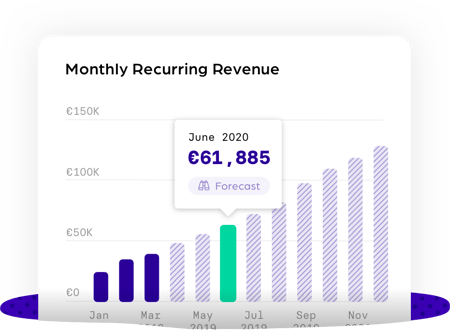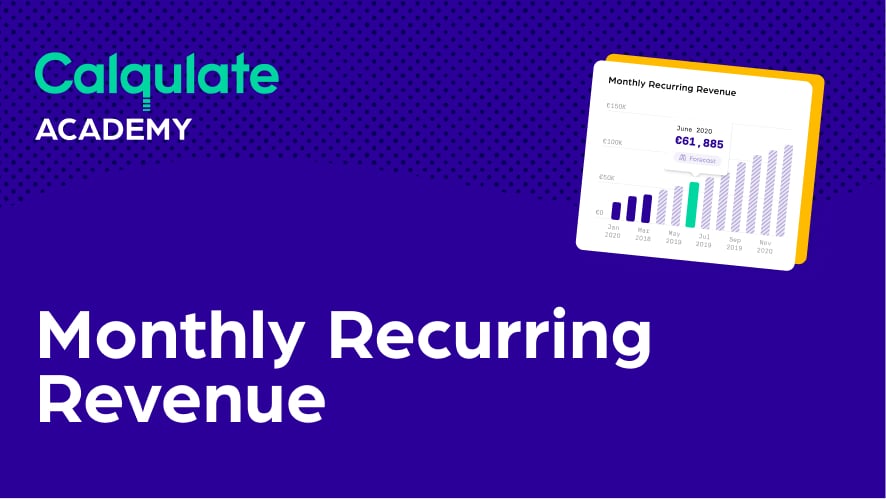Imagine this: You have a minimum monthly revenue goal of $100, and your product offering is a one-off purchase at $50 per unit. In order to achieve your monthly revenue goal, you need to ensure that you have two new purchases every single month.
Now, let’s change this scenario a little. Say, you still have a minimum monthly revenue goal of $100 and you have a product offering with an annual subscription of $600. All you need is to close one deal with two customers and you will have an MRR of $100 for the next 12 months without needing any new sales.
Instead of spending your time looking for new sales opportunities to ensure you hit your minimum revenue goal, you can now focus on scaling and growing your business by bringing in new MRR and upselling to expand your MRR.
That is the difference between having an MRR and not. You don’t have to worry about one-off monthly sales because you know that your company is generating income unless your customers stop returning. This is what makes building a SaaS business so appealing.
In this article, we will be taking a look at monthly recurring revenue.
What is a Monthly Recurring Revenue (MRR)?
MRR is the total monthly amount of your subscriptions. Calculating MRR is pretty straightforward. For example, if you sold an annual contract of $1200, the MRR for this month is $100. To get the total MRR, you just need to sum up the monthly amount of your subscriptions.
MRR per customer x Number of subscriptions = Total MRR

Let’s continue with this example. Assuming you sold 20 annual contracts. We know that your MRR per customer is $100. Therefore, your total MRR is:
$100 x 20 = $2000
Easy, right? But MRR is not just one thing. MRR has several layers, which we will cover in the following sections.
MRR is just one piece of the larger picture...
The formula above is only for your top level MRR. The difference between the monthly recognized revenue will tell you if your business is growing, contracting or stagnating month-on-month.
When you annualize your MRR, you will get the total amount of your Annual Recurring Revenue (ARR). An ARR is a key component in the valuation that is of paramount importance to investors.
What else can my MRR tell me?
As we’ve mentioned, there are many layers of MRR. These different layers of MRR will help you understand the reason for the changes in your top level MRR. Let’s break that down. The three basic types of recurring revenue are:
- New MRR - recurring revenue from new customers.
- Expansion MRR - recurring revenue from existing customers through upgrades or add-ons.
- Churned MRR - lost revenue from customers completely leaving you.
Tracking these three different layers of MRR helps you understand which part of your operation is doing well and which needs improvement. It also lets you know where your revenue or loss is coming from. In order to do that, we need to calculate your net new MRR, using the following formula:
New MRR + Expansion MRR - Churned MRR = Net New MRR
Dig deeper into the data and you will find information that is useful for decision making. For example:
If your net new MRR is growing at 10% on a month-to-month basis, it could be coming from new customers, expansion or reactivation. Maybe your sales and marketing strategy worked or there was a shift in market trends. Then it may be time to hire more personnel to accommodate the increasing demand.
If your new MRR is growing rapidly due to your sales and marketing efforts , but your net new MRR is contracting at 2% on a month-to-month basis, it means that your downgrade or churn rate is very high. Maybe your product is not the right fit. Perhaps your customers aren’t satisfied or aren’t receiving enough onboarding and support. Then it may be time to innovate or start shifting your focus to customer success.
How does this apply to a SaaS company?
Let’s take an online project management (SaaS) software company as an example. To calculate its top level MRR, we only need to know the number of customers and the billed amount for the average customer:
Number of customers: 14
Average billed amount per customer: $100/month
Total MRR = $1400
To make these calculations easier, here are the formulas:
Total MRR = MRR per customer x Number of subscriptions
Net new MRR = New MRR + Expansion MRR - Churned MRR
Let’s say the company’s MRR for Q3 is as such:
|
Total MRR |
New MRR |
Expansion MRR |
Churned MRR |
Net new MRR |
|
|
July |
1400 |
0 |
0 |
0 |
0 |
|
August |
1550 |
200 |
50 |
100 |
150 |
|
September |
1350 |
400 |
200 |
800 |
-200 |
In this scenario, we can see that the company has been growing fast in new MRR and expansion MRR on a monthly basis. However, the company churned a higher MRR than what it received from the new and expansion MRR for the month of September, thus resulting in a loss of total MRR for that month. There are many possible reasons for this churn rate, such as:
- Attracting the wrong customers
- Customers aren’t achieving their desired outcomes
- Customers don’t see value in your product
- There are better options in the market
- Your product is too expensive
- Customers are not getting the support they need
With this information in hand, the company can make adjustments in the areas that cause the loss of MRR to ensure rapid growth in the following months.
Conclusion
There are many ways to slice and dice your MRR metrics, and this is just one of them. Tracking irrelevant metrics will only distract you from focusing on the things that truly matter.
Your MRR helps you understand the factors that contribute to your business’s growth and the adjustments you need to make for the business to keep growing. Ultimately, you want your new and expansion MRR to far outweigh the churn rate.
Happy Calqulating!

